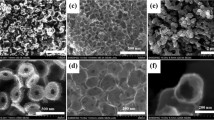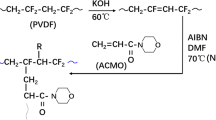Abstract
This paper presents the direct synthesis of highly nanoporous carbon materials via the carbonization of sodium oxalate in inert atmosphere without any activation. The carbonization temperature and time are very important for the carbon structures and their electrochemical performance in supercapacitors. The SOC–800–2.5 material derived from sodium oxalate has a high specific surface area of 1456 m2 g−1, and a total of 74 % of the pore volume is composed of mesoporosity with average pore size 3.7 nm, which is ideal for adoption as an electrode for supercapacitors. The SOC–800–2.5 material can also deliver a high specific capacitance of 245 F g−1 at a constant charge/discharge current of 0.7 A g−1. This capacitance is maintained at a value of 173 F g−1 at 10 A g−1. This material also has good cycle stability with over 89.1 % capacitance retention after 5000 cycles when measured in a three-electrode system using 6 M KOH as electrolyte.








Similar content being viewed by others
References
Aricò AS, Bruce P, Scrosati B, Tarascon J-M, Van Schalkwijk W (2005) Nanostructured materials for advanced energy conversion and storage devices. Nat Mater 5:366–377
Morita M, Arizono R, Yoshimoto N, Egashira M (2013) On the electrochemical activation of alkali-treated soft carbon for advanced electrochemical capacitors. J Appl Electrochem 4:447–453
Miller JR, Simon P (2008) Electrochemical capacitors for energy management. Sci Mag 5889:651–652
Simon P, Gogotsi Y (2008) Materials for electrochemical capacitors. Nat Mater 11:845–854
Miller JR, Outlaw RA, Holloway BC (2010) Graphene double-layer capacitor with ac line-filtering performance. Science 5999:1637–1639
Zhang G, Lou XWD (2013) General solution growth of mesoporous NiCo2O4 nanosheets on various conductive substrates as high-performance electrodes for supercapacitors. Adv Mater 7:976–979
Wei L, Sevilla M, Fuertes AB, Mokaya R, Yushin G (2011) Hydrothermal carbonization of abundant renewable natural organic chemicals for high-performance supercapacitor electrodes. Adv Energy Mater 3:356–361
Kishore B, Shanmughasundaram D, Penki TR, Munichandraiah N (2014) Coconut kernel-derived activated carbon as electrode material for electrical double-layer capacitors. J Appl Electrochem 8:903–916
Zhao X, Luo H, Du K, Zhang F, Li Y (2014) Application of attapulgite/maltose system on mesoporous carbon material preparation for electrochemical capacitors. J Appl Electrochem 6:719–725
Zhang L, Jiang J, Holm N, Chen F (2014) Mini-chunk biochar supercapacitors. J Appl Electrochem 10:1145–1151
Portet C, Yang Z, Korenblit Y, Gogotsi Y, Mokaya R, Yushin G (2009) Electrical double-layer capacitance of zeolite-templated carbon in organic electrolyte. J Electrochem Soc 1:A1
Portet C, Yushin G, Gogotsi Y (2007) Electrochemical performance of carbon onions, nanodiamonds, carbon black and multiwalled nanotubes in electrical double layer capacitors. Carbon 13:2511–2518
Ania CO, Khomenko V, Raymundo-Piñero E, Parra JB, Beguin F (2007) The large electrochemical capacitance of microporous doped carbon obtained by using a zeolite template. Adv Funct Mater 11:1828–1836
Chmiola J, Yushin G, Gogotsi Y, Portet C, Simon P, Taberna PL (2006) Anomalous increase in carbon capacitance at pore sizes less than 1 nanometer. Science 5794:1760–1763
Gu W, Yushin G (2014) Review of nanostructured carbon materials for electrochemical capacitor applications: advantages and limitations of activated carbon, carbide-derived carbon, zeolite-templated carbon, carbon aerogels, carbon nanotubes, onion-like carbon, and graphene. Wiley Interdiscip Rev 5:424–473
Salitra G, Soffer A, Eliad L, Cohen Y, Aurbach D (2000) Carbon electrodes for double-layer capacitors I. Relations between ion and pore dimensions. J Electrochem Soc 7:2486–2493
Raymundo-Pinero E, Kierzek K, Machnikowski J, Béguin F (2006) Relationship between the nanoporous texture of activated carbons and their capacitance properties in different electrolytes. Carbon 12:2498–2507
Ahmadpour A, Do D (1996) The preparation of active carbons from coal by chemical and physical activation. Carbon 4:471–479
López-Ramón M, Moreno-Castilla C, Rivera-Utrilla J, Hidalgo-Alvarez R (1993) Activated carbons from a subbituminous coal: pore texture and electrokinetic properties. Carbon 5:815–819
Maciá-Agulló JA, Moore BC, Cazorla-Amorós D, Linares-Solano A (2004) Activation of coal tar pitch carbon fibres: physical activation versus chemical activation. Carbon 7:1367–1370
Teng H, Yeh T-S, Hsu L-Y (1998) Preparation of activated carbon from bituminous coal with phosphoric acid activation. Carbon 9:1387–1395
Wang J, Kaskel S (2012) KOH activation of carbon-based materials for energy storage. J Mater Chem 45:23710–23725
Williams PT, Reed AR (2004) High grade activated carbon matting derived from the chemical activation and pyrolysis of natural fibre textile waste. J Anal Appl Pyrol 2:971–986
Williams PT, Reed AR (2006) Development of activated carbon pore structure via physical and chemical activation of biomass fibre waste. Biomass Bioenergy 2:144–152
Xu B, Hou S, Cao G, Wu F, Yang Y (2012) Sustainable nitrogen-doped porous carbon with high surface areas prepared from gelatin for supercapacitors. J Mater Chem 36:19088–19093
Zhao L, Fan LZ, Zhou MQ, Guan H, Qiao S, Antonietti M, Titirici MM (2010) Nitrogen-containing hydrothermal carbons with superior performance in supercapacitors. Adv Mater 45:5202–5206
Fan Z, Qi D, Xiao Y, Yan J, Wei T (2013) One-step synthesis of biomass-derived porous carbon foam for high performance supercapacitors. Mater Lett 101:29–32
Li Z, Zhang L, Amirkhiz BS, Tan X, Xu Z, Wang H, Olsen BC, Holt C, Mitlin D (2012) Carbonized chicken eggshell membranes with 3D architectures as high-performance electrode materials for supercapacitors. Adv Energy Mater 4:431–437
Endo M, Kim Y, Takeda T, Maeda T, Hayashi T, Koshiba K, Hara H, Dresselhaus M (2001) Poly (vinylidene chloride)-based carbon as an electrode material for high power capacitors with an aqueous electrolyte. J Electrochem Soc 10:A1135–A1140
Ćirić-Marjanović G, Pašti I, Gavrilov N, Janošević A, Mentus S (2013) Carbonised polyaniline and polypyrrole: towards advanced nitrogen-containing carbon materials. Chem Pap 8:781–813
Salavagione HJ, Gómez MA, Martínez G (2009) Polymeric modification of graphene through esterification of graphite oxide and poly (vinyl alcohol). Macromolecules 17:6331–6334
Sevilla M, Fuertes AB (2012) CO2 adsorption by activated templated carbons. J Colloid Interface Sci 1:147–154
Su F, Poh CK, Chen JS, Xu G, Wang D, Li Q, Lin J, Lou XW (2011) Nitrogen-containing microporous carbon nanospheres with improved capacitive properties. Energy Environ Sci 3:717–724
Xu B, Duan H, Chu M, Cao G, Yang Y (2013) Facile synthesis of nitrogen-doped porous carbon for supercapacitors. J Mater Chem A 14:4565
Xu B, Zheng D, Jia M, Cao G, Yang Y (2013) Nitrogen-doped porous carbon simply prepared by pyrolyzing a nitrogen-containing organic salt for supercapacitors. Electrochimica Acta 98:176–182
Atkinson JD, Rood MJ (2012) Preparing microporous carbon from solid organic salt precursors using in situ templating and a fixed-bed reactor. Microporous Mesoporous Mater 160:174–181
Sevilla M, Fuertes AB (2013) A general and facile synthesis strategy towards highly porous carbons: carbonization of organic salts. J Mater Chem A 44:13738–13741
Pradhan BK, Sandle N (1999) Effect of different oxidizing agent treatments on the surface properties of activated carbons. Carbon 8:1323–1332
Short M, Walker P (1963) Measurement of interlayer spacings and crystal sizes in turbostratic carbons. Carbon 1:3–9
Wang Y, Su F, Wood CD, Lee JY, Zhao XS (2008) Preparation and characterization of carbon nanospheres as anode materials in lithium-ion secondary batteries. Ind Eng Chem Res 7:2294–2300
Kajdos A, Kvit A, Jones F, Jagiello J, Yushin G (2010) Tailoring the pore alignment for rapid ion transport in microporous carbons. J Am Chem Soc 10:3252–3253
Korenblit Y, Rose M, Kockrick E, Borchardt L, Kvit A, Kaskel S, Yushin G (2010) High-rate electrochemical capacitors based on ordered mesoporous silicon carbide-derived carbon. ACS Nano 3:1337–1344
Sadezky A, Muckenhuber H, Grothe H, Niessner R, Pöschl U (2005) Raman microspectroscopy of soot and related carbonaceous materials: spectral analysis and structural information. Carbon 8:1731–1742
Jurewicz K, Vix-Guterl C, Frackowiak E, Saadallah S, Reda M, Parmentier J, Patarin J, Béguin F (2004) Capacitance properties of ordered porous carbon materials prepared by a templating procedure. J Phys Chem Solids 2:287–293
Lee J, Sohn K, Hyeon T (2001) Fabrication of novel mesocellular carbon foams with uniform ultralarge mesopores. J Am Chem Soc 21:5146–5147
Frackowiak E (2006) Supercapacitors based on carbon materials and ionic liquids. J Braz Chem Soc 6:1074–1082
Zhou G, Wang D-W, Li F, Zhang L, Li N, Wu Z-S, Wen L, Lu GQ, Cheng H-M (2010) Graphene-wrapped Fe3O4 anode material with improved reversible capacity and cyclic stability for lithium ion batteries. Chem Mater 18:5306–5313
Jiang H-L, Liu B, Lan Y-Q, Kuratani K, Akita T, Shioyama H, Zong F, Xu Q (2011) From metal-organic framework to nanoporous carbon: toward a very high surface area and hydrogen uptake. J Am Chem Soc 31:11854–11857
Hulicova D, Kodama M, Hatori H (2006) Electrochemical performance of nitrogen-enriched carbons in aqueous and non-aqueous supercapacitors. Chem Mater 9:2318–2326
Xu B, Yue S, Sui Z, Zhang X, Hou S, Cao G, Yang Y (2011) What is the choice for supercapacitors: graphene or graphene oxide. Energy Environ Sci 8:2826
Lozano-Castello D, Calo J, Cazorla-Amoros D, Linares-Solano A (2007) Carbon activation with KOH as explored by temperature programmed techniques, and the effects of hydrogen. Carbon 13:2529–2536
Romanos J, Beckner M, Rash T, Firlej L, Kuchta B, Yu P, Suppes G, Wexler C, Pfeifer P (2012) Nanospace engineering of KOH activated carbon. Nanotechnology 1:015401
Acknowledgments
This work was financially supported by the National Natural Science Foundation of China (NSFC, Nos. 51462020 and 21364004) and the Excellent Young Teachers in Lanzhou University of Technology Training Project (1005ZCX016).
Author information
Authors and Affiliations
Corresponding author
Rights and permissions
About this article
Cite this article
Luo, H., Yang, Y., Sun, Y. et al. Highly nanoporous carbons by single-step organic salt carbonization for high-performance supercapacitors. J Appl Electrochem 45, 839–848 (2015). https://doi.org/10.1007/s10800-015-0850-z
Received:
Accepted:
Published:
Issue Date:
DOI: https://doi.org/10.1007/s10800-015-0850-z




